We all know that unexpected situations like hurricanes, summer or winter storms, tornadoes, earthquakes, etc. can happen at any time, all year round. This is especially true in areas prone to such disasters. The higher the risk for a specific area, the better should you be prepared. It isn’t about whether you fear or dread these natural disasters, but about preparedness. The more knowledge and time spent on the preparation, the less panic and fright when the unexpected happens.
[the_ad_placement id=”in-text-1-type-r”]You need to rely on something, and that is both knowledge of such emergencies, and the survival kit. You can compile one yourself, or buy it online. Whichever you choose, you need to follow some guidelines on what is a must in the survival kit. And another thing, don’t just buy it, and then forget about it. You have to take note on each and every item in the kit, and know how, why and when to use it when the situation occurs. Here we will help you by guiding you though all the vital items and giving you a more in-depth description about each one.
Specific season preparedness
The optimal decision is to be prepared for each season. If this is necessary or not, it is up to you. You still need to know some specifics about the two main seasons. If you need to be prepared for the summer you should know that you may have to be prepared for floods, heavy rain, summer storms and hurricanes, strong destructive winds, and in extreme cases you may have to abandon your home. That’s where the survival kit may be of crucial help.
There may have to season specific items you’d need in addition to the rest in your kit – sunscreen, umbrella, towels or blankets, insect repellent.
The winter survival kit may have items related to the season, which have nothing to do with sunscreen and bug repellents. You may need items like additional clothing, both wind- and waterproof with warm layers like Lycra and wool, folding shovel, etc.
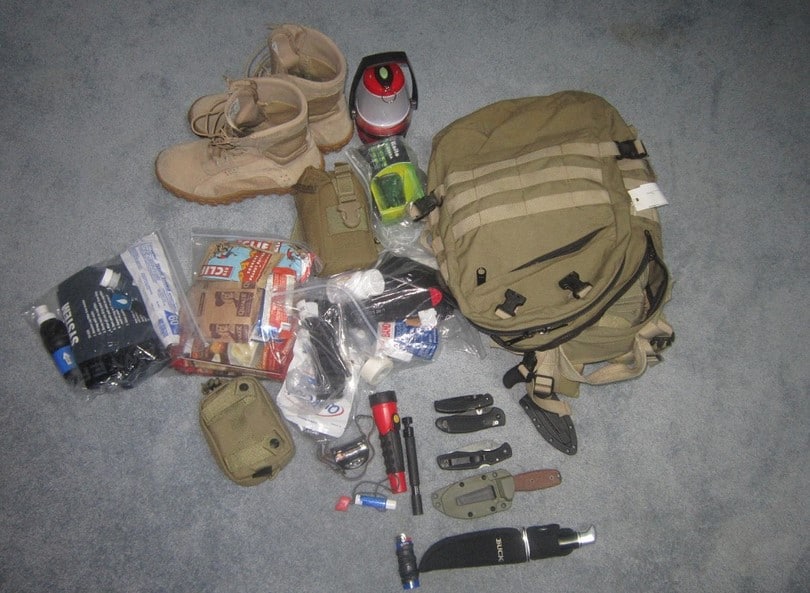
It is good to be aware of the specifics of the season. We will include all items and mention if each is specific for the summer or winter, to help you plan your 3-day survival kit better. Of course, it is easier to prepare a four-season survival kit, so as to avoid confusion when disaster strikes. Thus, you can act immediately and skip the fuss.
What you have to put in a survival kit?
So here comes the big question. What to actually have in the 3-day survival kit?
- Water. It is no surprise that water is the topmost item you have to consider. Humans cannot survive more than 3 days without water. Dehydration kills quicker than starvation. To avoid dehydration though an adult person needs at least 1 liter a day. So, since we’re preparing a 3-day survival kit, you’ll need at least 3 liters.
It is highly advisable to find room in the bag for a water purifying system, in case your survival situation continues beyond 3 days. This way you can search for water sources and purify the water, to avoid catching some disease. Dirty water can be as deadly as no water. Consider water for each family member, if you have any. A very good option for water purifying is Sawyer water filter, you can learn more about it in this article. - Food. Second in the list is of course food. You can find food that lasts for months, even years. Good idea for long lasting food is energy bars, canned food, dried fruits like resins, dates, nuts, chocolate bars, powdered soups that can be mixed with hot or boiled water (purified). Anything that lasts long and is light-weighted is perfect. You should know which is the best prepped food to store for an emergency situation and for that, you can take a look at our in-depth article about this. If you carry along canned food you shouldn’t forget spoons, forks and knife. Most importantly though is the can opener.
Find the one easiest to handle. Try it at home first. You may even want to try several and test them, to see which is easiest and safest. - Clothes. Without saying, good clothing is a lifesaver. No matter if its winter or summer you have to add warm clothes to your survival kit. You will need the following things:
-
- Waterproof shoes or boots. When looking for such, the best idea is to opt for four-season boots. They may be similar to trekking boots.
- Water- and windproof pair of pants. No matter if there’s flooding or 3-meter snow out there, if your pants are wind- and waterproof, they’ll help immensely.
- At least two pairs of socks. The best idea is to get wool socks. They keep the skin well ventilated and warm at the same time.
- Underwear made of Lycra. It keeps the skin dry and warm.
- Wind- and waterproof jacket. This follows the same idea as with the pair of pants. You need to be protected from the elements.
- Warm hat and a bandana. There are many applications for a bandana. It can be used for a hat, scarf, small bag, wrist or knee band, to wrap around wounds, etc.
- Shelter. It may happen so that for 3 days you have to be entirely exposed to the weather. Whatever it is, there are certainly tools to help you survive. The easiest and most compact shelter on the market is the tarp. Depending on what size you opt for, the tarp may be light or slightly heavier. If you have a large family you want to protect, best get the largest possible.
The excess part of it may be used for stabilization, binding, etc. There are many ways and methods to build a good shelter using a tarp. Another option is to buy a tent. Tents are usually heavier and not as compact, but if you prefer it, by all means, add it to your survival kit. Don’t forget to add some sleeping pads to have your ground dry. There are very compact pads on the market.
Depending on the weather, a sleeping bag may be of life-saving importance. If it is wintertime and you’re totally exposed to the weather, a sleeping bag will save you. Even if you just wrap yourself with it, to keep you warm. If its summer and you don’t expect low temperatures, a tarp and good warm clothes may be enough. Consider your situation and prepare a sleeping bag in case of need.
All of these put together will make a good bug out bag and if you want to build your own with detailed instruction, read our article about the best survival bug out bag. - First-aid kit. Yet another must-have to add to your list. If you already have a first-aid kit, check that all items are present. Consider adding or removing (un)necessary items, such that have expired, batteries not used for more than three months, etc. There are many first-aid kits on the market, but it is always a good idea you build your own. You will be much more familiar with it than anyone else, and it’s customizable. Here are some suggestions:
-
- Basic supplies – duct and adhesive tape; bandages and Band-Aids; antibiotics; antiseptic cream, cotton balls; disposable gloves (synthetic); lubricant (e.g. petroleum jelly); plastic bags; scissors (find small and compact ones); soap or sanitized tissues; thermometer; gauze pads of various sizes.
- Medications – activated charcoal (instruct yourself how to use it beforehand); aloe Vera gel; medication against diarrhea; antihistamine; aspirin or other over-the-counter painkiller; other medication if you have special conditions; medication in case of allergic attack; medicine cup or small spoon.
- Emergency supplies – List of all emergency phone numbers, both national and local; medical history of all members of your family, including their medical consent forms; flashlight and batteries for it (including an extra set); matches; sunscreen (can be important all year round, mostly in summer seasons);
We advise that you also add a first-aid kit manual, you need to know how to use each item, when and which item is best for which situation.
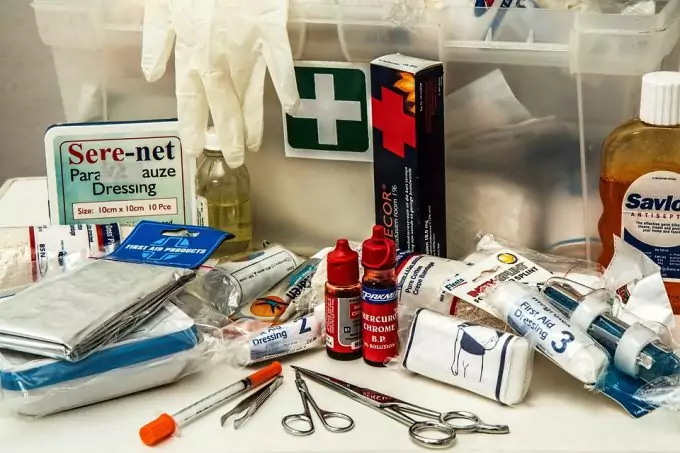
In addition to all that, it is a very good idea to get a large plastic bag in which to put all listed items. This will be extremely important in rain, flood and humid conditions. If half of your supply gets wet it will be totally useless.
Still, if the idea of getting an already built first aid kit, try one of the kits we reviewed in our great article about the best ones available on the market.
[the_ad_placement id=”in-text-2-type-r”]What else you will need:
- Survival tools. Here are included – compact knife, lighter, matches and/or flashlight (may be part of your first-aid kit) and several extra sets of batteries, tools for cooking, like a small compact cooking stove, some sort of a defending weapon, like larger knife or a firearm. No matter if you’re in civilization or in nature, you may have to defend yourself. Disaster situations may go out of control and you need to be prepared. You need to stay on top of the game, and for that, we have a complete article about building your own survival tool set, you can read it here.
- Cell phone. It may go without saying but it is a good reminder to be aware that a cell phone may help you being located. If a GPS system is activated, the rescue mission may not take very long to find you. Take also a battery charger and even several batteries for your specific cell or smart phone model. Another idea is to get a solar panel.
- Maps and compass. Equip yourself with a map of your area (or the area you’re at) and a compass. Teach yourself how to use a map and compass, if you haven’t already. In case you have damaged or lost your cell or smart phone, and you can’t use a GPS system, the old-fashioned map and compass may be of huge importance. If a map is easy to read, a compass might be harder to use, but a quick learn about it will eliminate that problem. Learn the fundamentals of orienteering from our article on how to use a compass.
- Whistle. A good way to give a signal to your rescue team. It is also a good way to communicate with your family members. If everyone has a whistle you may build a message system to communicate while in large distances. For example, when you research an area or are looking for food/water/shelter, and you’re divided in teams. A good option is Storm all weather safety whistle, take a look at it and the other great options in our emergency whistle review article.
- Poncho or other rain gear. No matter if you have a waterproof jacket, if the situation is too extreme, a poncho can always be helpful. Sometimes even the best waterproof jacket can let water through. But ponchos, being entirely made of plastic, can’t. The only downside is that it may trigger a condensation effect beneath it but since ponchos are usually large and spacy, this may be an unimportant concern.
- Towels, sheets and blankets. We already mentioned the sleeping pad, but we need to also mention the towels and sheets. They can be used in various situations.
- Reflective band. If you don’t have active light, a reflective one may still be of enormous help. Don’t miss that one.
- Nylon rope. It’s light and extremely important. It has various applications. From binding things together, to building up a snare, and even to saving lives. Add to it fishing hooks and you can even catch your own food in case something happens to your survival kit food.
- Sewing needle and nylon thread. In combination they may help sewing damaged clothes and also open woods (which must be sanitized).
Easily damages are the matches and various electronics, including clothes and towels.
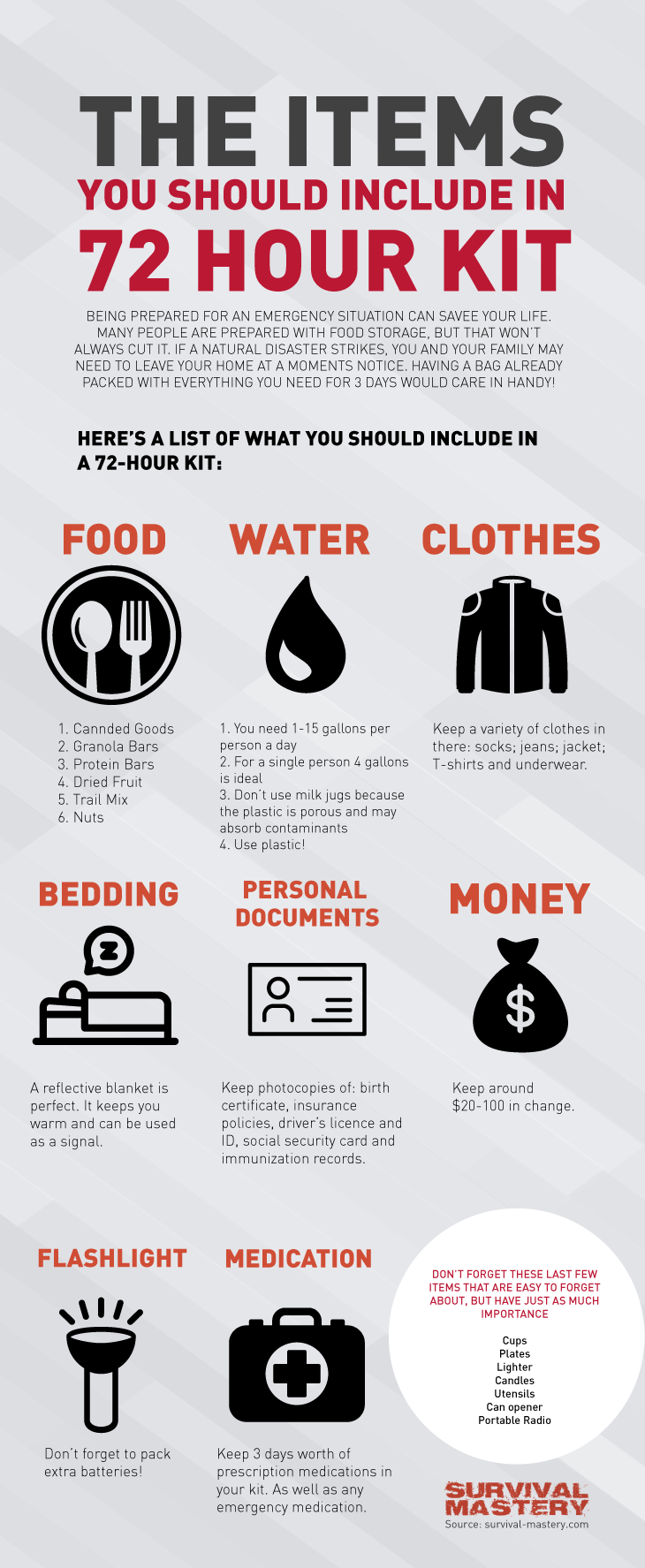
You definitely should keep those perfectly dry.
What to consider when buying your kit in store?
An important thing is to prepare your kit depending on how many family members you have. You may want to have all necessary items in one bag only, or spread it evenly among the adult members (you, your spouse and an adolescent). If the adult members are just you and your partner, spread that load among you two. The children shouldn’t carry anything so as not to burden them unnecessarily. They may lose some items or even the entire bag. Plan your load well.
From basic kits to complete ones, read about the list of the very best survival kits we’ve made in this article and pick your favorite. In an emergency situation, it may be the difference between having everything you need or waiting for a miracle.
It is good to decide if you want to reuse the survival kit or you’ll keep only the one-time items. If you plan a 3-day survival kit, pay more attention to items that can be used more than once, preferably for at least 3 days. Don’t consider the 3-day survival kit as just a one-time thing. Make it part of your life and get used to it. Teach your younger family members to use it too.
Be careful not to overburden yourself. You may think of thousand reasons why to take this or that item, but you risk making your survival kit too heavy to be considered survival. It will slow you down and will exhaust you in case you need to walk for miles. Stick to the above list and consider the disaster conditions.
Take into account the environment. When night comes you must be prepared to pick a shelter location. During the winter season you may want to choose to build your shelter under a tree. If in the forest, build a fire also, to repel wild animals. During the summer, the shelter is especially good against the strong sun, so again, trees can save you from the heat. In a rainy season any place may be dangerous. Yet try to look for elevated areas, like buildings, in case of flooding.
If there’s a thunderstorm, stay away from tall buildings and hide under roofs, and not trees. Though lightning strike not only tall buildings and rooftops, it’s safest in the lowest parts of buildings and houses. Use your flashlight and search for the best area to spend the night. Stick together. Tie your family members to yourself so that no one gets lost in the dark, fog, wind, etc.
[the_ad_placement id=”in-text-3-type-r”]When you have to abandon your house or home quickly, don’t forget to take along some cash. This is important, since machines and ATM’s may be out of service and credits card will be unusable. Keep small bills (you will not be shopping expensive things or food, and you won’t worry about the change). If you’re stuck in other public buildings you may want to have coins, in case there is a food machine, and it doesn’t accept cash or credit cards.
If you have a baby, you absolutely must consider that and prepare all necessary toiletries for taking care of it. Don’t forget the extra clothes, baby food, diapers, etc. Even a toy or two is a good idea, to keep your baby distracted, or at least to help it fall asleep.
Don’t forget any of your personal documents. We already mentioned the medical records, but you must add to that insurance documents, bank account numbers, ID card, passport, credit card(s). Keep those in a plastic bag with a zipper. Make sure no water can penetrate it. Check for damages or holes on the plastic bag, or get a new one.
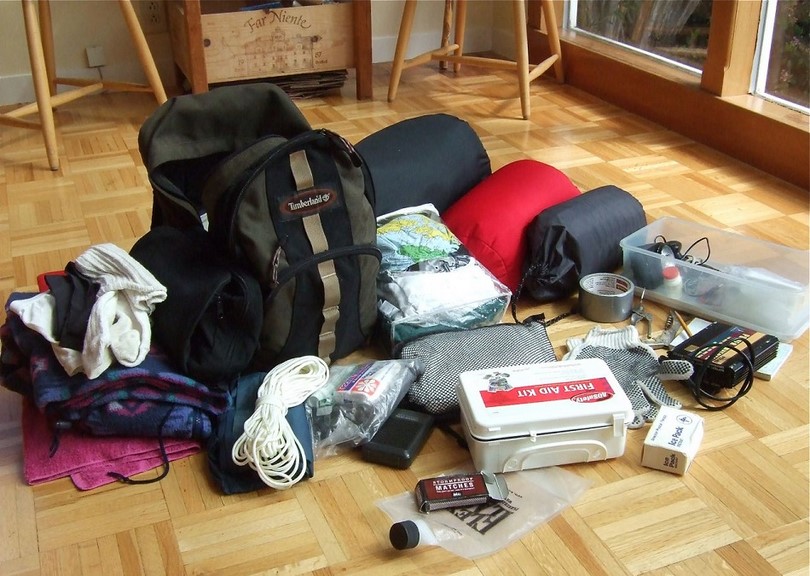
An easily neglected thing is any pet you may have. Some people abandon their pets and hope they will survive somehow. If you cannot leave your four-legged companion you may want to add to your survival kit several more items. These include water and food, the amount depends on the animal’s size; leash, to make sure it won’t get lost or dragged by strong currents; protective life-vest.
In case the animal gets lost and dragged by water currents, it will stay above the surface and be able to breathe. Get a life vest with reflective stripes for better chances of survival. Don’t forget the pet’s identification, immunization and medical records. If you have a cat, get a cage or other carrier.
At a first glance all this information may be overwhelming but it certainly saves lives. If you make a proper list according to your family status and you consider well the weather conditions and season specifics of your area, you have strong chances of survival. Test some of the tools, go on a trial expedition for 3 days and check in practice if something may have to be added to the above list. You may face a situation specific to your area that needs special preparation.
Learn to use a map and a compass. It is often an overlooked skill, but it certainly pays off. You can also read about more old-fashioned ways to find your location, by the stars, for example. The 3-day survival kit will provide you with all necessary tools for survival, but you also have to equip yourself with knowledge and experience.

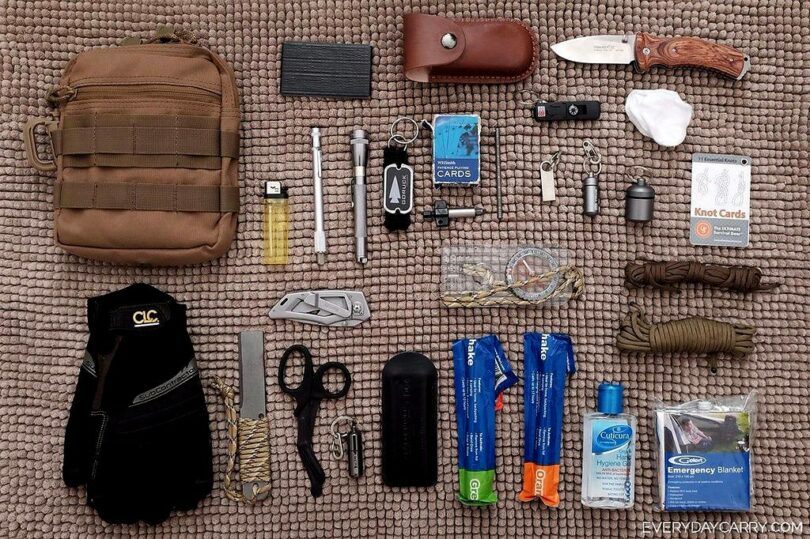
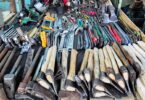
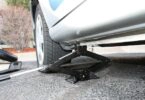


I like how the articles didn’t skip the small details as they are missing in other articles I read. I have a readymade kit, but it is missing vital items like the whistle and the sewing needle, so I guess I’ll have to update my package. I also need to add more tools to my first aid kit.
This is a good article. I would like to add some like getting yourself a stainless and waterproof box, bag or plastic for your documents and other related stuff that shouldn’t be drenched in water. Have as much as meal replacement energy bars that have a good fat content. If there are women in your household, you should tell them to bring their additional necessities too.
Thank you for sharing your tips with us Michael.
Glad to be of help Jonas.
I like how the article pointed out the gear that is really necessary, not overloading with too many tools that are not a must for a 3 day survival kit. People have a really hard time understanding what is expandable and what is required to take on a trip. More gear means more weight, which is not ideal, as you said it slows you down and in a situation where you have to walk for miles it will become exhausting. I will definitely backpack light on my next expedition.
The secret to a successful backpacking trip is to pack light, especially on a solo trip. This is an important consideration to factor in when preparing your 72-hour survival kit.